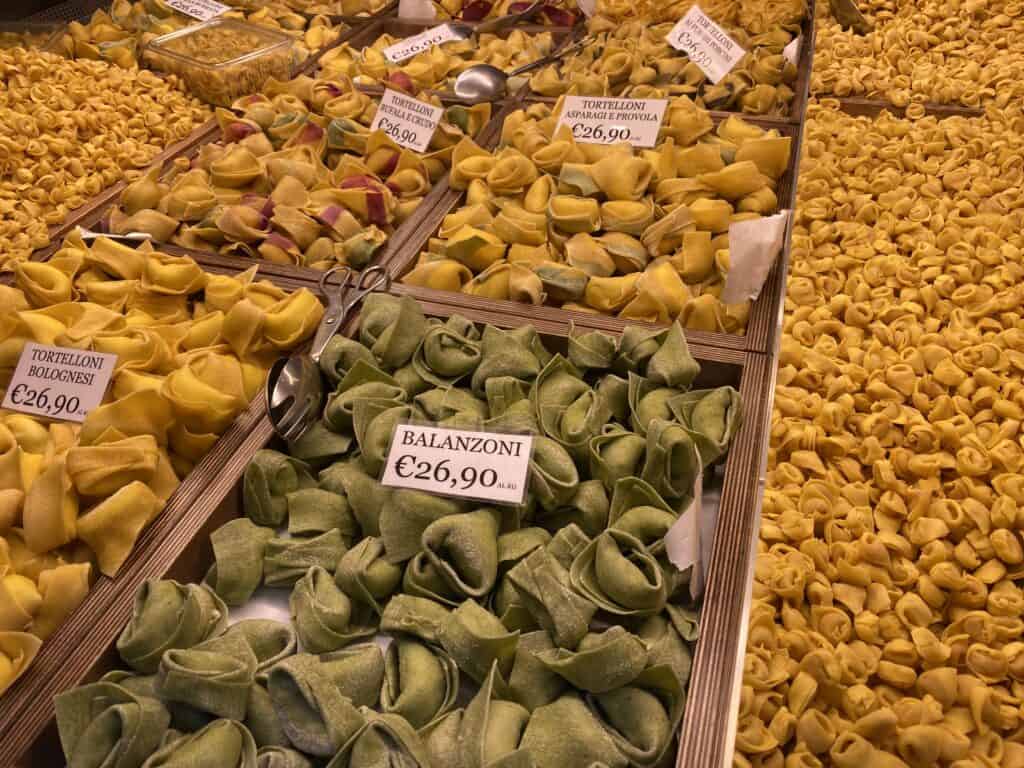Last updated on April 19th, 2024
It’s true, Venice is absolutely amazing, stunning, THE city to write home about, so yes, you should visit.
But what about everything else in Veneto? Often, travelers bypass the rest of the region and head straight to Venice, but there is so much out there, especially from a culinary point of view.
I’ll walk you through the traditional food of the Veneto – starting in Venice but also diving into Verona, Vicenza, Lake Garda and all the other small towns boasting fabulous food (and wine!). My knowledge of Veneto’s food and wine is extensive, based on first-hand experiences in the top destinations and out in the countryside.
This food guide will be your best friend as you move through Veneto. I’ll provide you with thorough descriptions of the regional dishes and where to get them. I’ll also list the most prominent local ingredients and flavors and briefly describe the regional wines.
Jump to Section
Food from Veneto vs Italian Food

Similar to the rest of Italy, Veneto’s cuisine is defined by its geography: the Dolomite mountains on the Austrian border bump shoulders with beautiful vineyards in the Po Valley. And then there is the Adriatic coast, where we find Venice. What you eat on the mainland will be very different from what you eat on the coast; we are talking meat vs. seafood.
And just like the rest of Italy, Veneto loves their carbs, but here they are partial to rice and polenta. Pasta is much less common. Vialone Nano Veronese rice is grown just outside of Verona, making risotto the top primo pick. It’s dressed up and flavored with seasonal vegetables and seafood, while polenta is served just about any way possible: sliced, toasted, fried or slow-cooked and served as a meal in itself.
The Adriatic Sea provides bountiful fresh fish for the locals, including mussels, clams, crabs, anchovies, sprats, bream and sea bass. If you are not a fan of seafood – don’t worry – the region is big on cheese, and being a neighbor to Austria, it can’t help but love pork and beef.
If you like drinking wine, you are in the right spot as Veneto produces some of Italy’s most famous varieties. And let’s not forget – Veneto is home to the famous Aperol Spritz! And what would good drinks be without good snacks? The cicchetti culture in Venice is a way of life, so we will start there.
Cicchetti

(Pronounced cheek-keht-tee in Italian)
Some consider this to be the best Venetian cuisine and a (or the, depending on who you are talking to) way of life in Venice. Essentially, they are small bites similar to the Spanish tradition of tapas. If you do nothing else on your trip, visit a bacaro and order a couple of glasses of wine and a plate of cicchetti for a truly delicious and authentic experience. Here are our top 10 options to suit any meat lover, seafood enthusiast or vegetarian.
Foodie Experience: Eat your heart out with the locals at local cicchetti bars. Read more about this amazing experience in Italy Foodie Bucket List – 17 Amazing Italian Culinary Experiences by Region and My Favorite Cicchetti in Venice. And make sure you’re pronouncing cicchetti correctly!

- Baccalà mantecato (pronounced bahk-kah-lah mahn-teh-cah-toh in Italian): a creamy puree of salt cod is served on small rounds of toasted bread or crispy pieces of polenta. This is a must try!
- Polpette di pesce (pronounced pohl-peht-teh dee peh-sheh in Italian): these are small, deep fried fish balls served with various sauces.
- Sarde in saor (pronounced sahr-deh in sow-oor in Italian): local sardines are fried in oil and flavored with raisins, pine nuts and white wine vinegar. It makes for the perfect salty, sour, sweet combination.
- Spiedino di frittura (pronounced spee-eh-dee-noh dee freet-toor-ah in Italian): a selection of local fried fish on a skewer.
- Crostino con salmone affumicato (pronounced croh-stee-noh cohn sahl-moh-neh ahf-foo-mee-cah-toh in Italian): a small piece of toasted white bread spread with cream cheese and smoked salmon. Perhaps not too exciting but very common nonetheless.
- Polpette Veneziane (pronounced pohl-peht-teh veh-neh-zee-ah-neh in Italian): deep fried beef meatballs. Venice is well known for these little guys so don’t miss them!
- Bruschetta con pomodoro e basilico (pronounced broo-skeht-tah cohn pohm-oh-dohr-oh eh bah-see-lee-coh in Italian): your classic toasted slice of bread piled high with vine ripe tomatoes, fresh basil and a drizzle of olive oil.
- Bruschetta con gorgonzola e noci (pronounced broo-skeht-tah cohn pohm-oh-dohr-oh eh noh-chee in Italian): toasted bread with gorgonzola cheese and walnuts, sometimes with a drizzle of honey to balance it all out.
- Affettati (pronounced ahf-feht-tah-tee in Italian): various local cured meats such as bresaola, sporessa and coppa, just to name a few.
We recommend for the best cicchetti
- El Sbarlefo (Venice): boasts an extensive wine list
- All’Arco (Venice): particularly good sarde in saor
- Osteria Bancogiro (Venice)
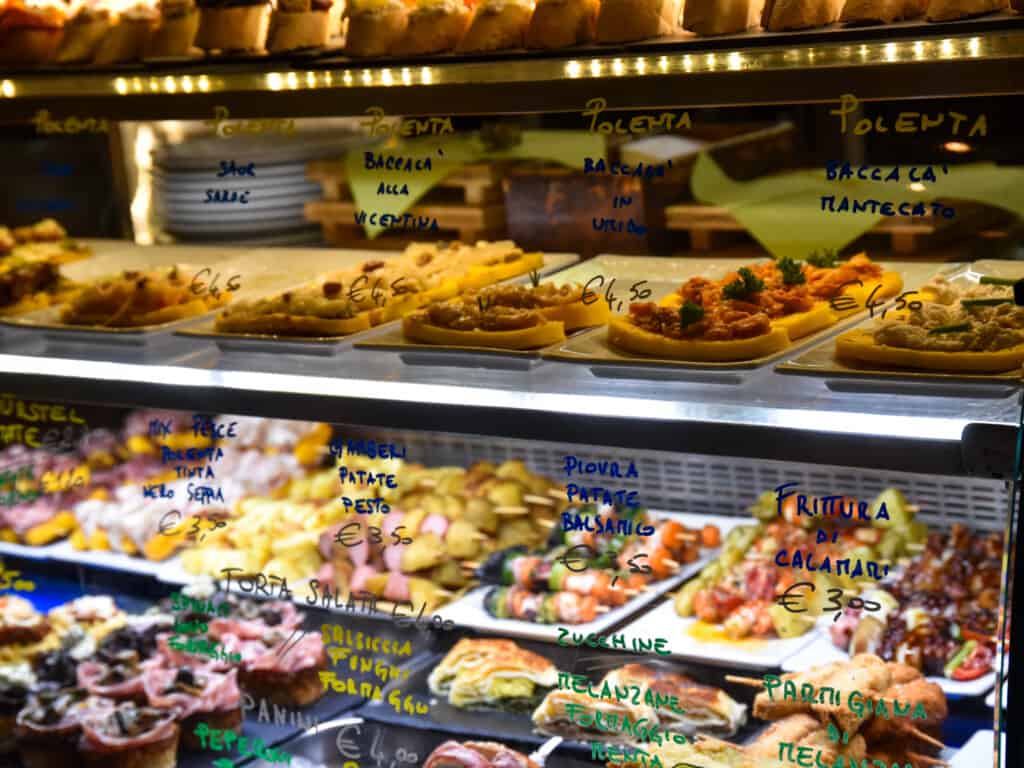
Asiago

(Pronounced ah-see-ah-goh in Italian)
This DOP, semi-hard cow’s milk cheese is sold in several ways, either fresh known as pressato or aged. There are three aged varieties – Mazzano, aged 4-10 months, Vecchio, aged 10+ months and Stravecchio, aged 15+ months. This sweet cheese has beautiful melting properties when it is young and its flavor becomes more spicy and complex as it ages.
Ubriaco
(Pronounced oo-bree-ah-coh in Italian)
This cheese is believed to have been first made during WWI when local farmers would hide their cheese from soldiers in wine barrels. Made in Treviso, this cow’s milk cheese is finished aging in Prosecco and the leftover grape seeds and skin from the process of making wine. The texture is soft but becomes crumblier as it ages.
Fun Fact: Ubriaco means ‘drunk’ in Italian.
Morlacco

(Pronounced mohr-lahk-koh in Italian)
Also called Morlacco di Grappa, this cow’s milk cheese is snow white with a fresh and delicate flavor. It’s aged anywhere from 20 days up to three months but no matter the age, this cheese pairs well with sweet notes such as fruits and jams.
Piave
(Pronounced pee-ah-veh in Italian)
Named after the river which runs through the province of Belluno in northern Veneto, Piave is a cooked cheese made from cow’s milk and is available either fresco (fresh) or stagionato (aged) for various lengths of time. Mezzano is aged for 60-80 days, Vecchio is aged for 6+ months, Vecchio Selezione Oro is aged 12+ months and Vecchio Riserva is aged for 18+ months. Because this cheese is sold at so many different stages in its aging process, it’s a very versatile cheese great for adding in all sorts of dishes such as in souffles, pastas, rices, or enjoyed as is.
Monte Veronese
(Pronounced mohn-teh vehr-oh-neh-seh in Italian)
A semi-hard cheese made from cow’s milk produced in the province of Verona. It’s either sold as latte intero made with whole milk and aged for one month. This type is softer than its sister cheese d’Allevo made from part-skim milk but aged for three months.
Soprèssa Vicentina
(Pronounced soh-prehs-sah vee-chehn-tee-nah in Italian)
Soprèssa Vicentina is Veneto’s most famous salame made from various cuts of pork flavored with salt, pepper and other spices. Aged anywhere from 2-6 months, this cured meat is soft and sweet, most commonly enjoyed with bread or cooked with polenta.
Prosciutto Veneto Berico-Euganeo

(Pronounced proh-shoot-toh veh-neh-toh beh-ree-koh yoo-jah-nee-oh in Italian)
This ancient prosciutto is made in the Po valley and around the Berici and Euganean Hills. It is described as being light yet rich with a delicate aroma ideal for eating on a charcuterie board as an appetizer.
Prosciutto Veneto Berico-Euganeo is one of our top picks for Types of Prosciutto to Try on Your Next Trip to Italy.
Carpaccio

(Pronounced kahr-pahch-choh in Italian)
Paper-thin slices of raw fish or beef are plated with a drizzle of olive oil, a shaving of cheese and a squeeze of lemon. Carpaccio was first made in 1950 by the Venetian Giuseppe Cipriani, the owner of Harry’s Bar. He named the dish after one of his favorite artists, Vittore Carpaccio, whose bold colors reminded Cipriani of the color of the raw red meat.
Prosciutto e Fichi

(Pronounced proh-shoot-toh eh feek-kee in Italian)
Prosciutto e fichi is a staple among locals at the height of fig season in late August-early September. Sweet figs, ideally the settembrini fig, are paired with salty prosciutto crudo making for the perfectly balanced combination of sweet and salty you could ask for.
Saor

(Pronounced sow-oor in Italian)
Saor means “flavor” in the local dialect, referring to the technique used to create a flavorful preserve of white onions, pine nuts and raisins cooked in oil, vinegar, and white wine, which can be used to amp up flavor profiles of various foods.
Polenta e Schie
(Pronounced poh-lehn-tah eh shee-eh in Italian)
Originally made as a poor man’s dish, polenta e schie is now considered a very refined and fancy appetizer in Veneto. Locally caught small shrimp are either boiled or fried, flavored with lots of seasonings and served on a heap of soft, creamy polenta.
Bigoli
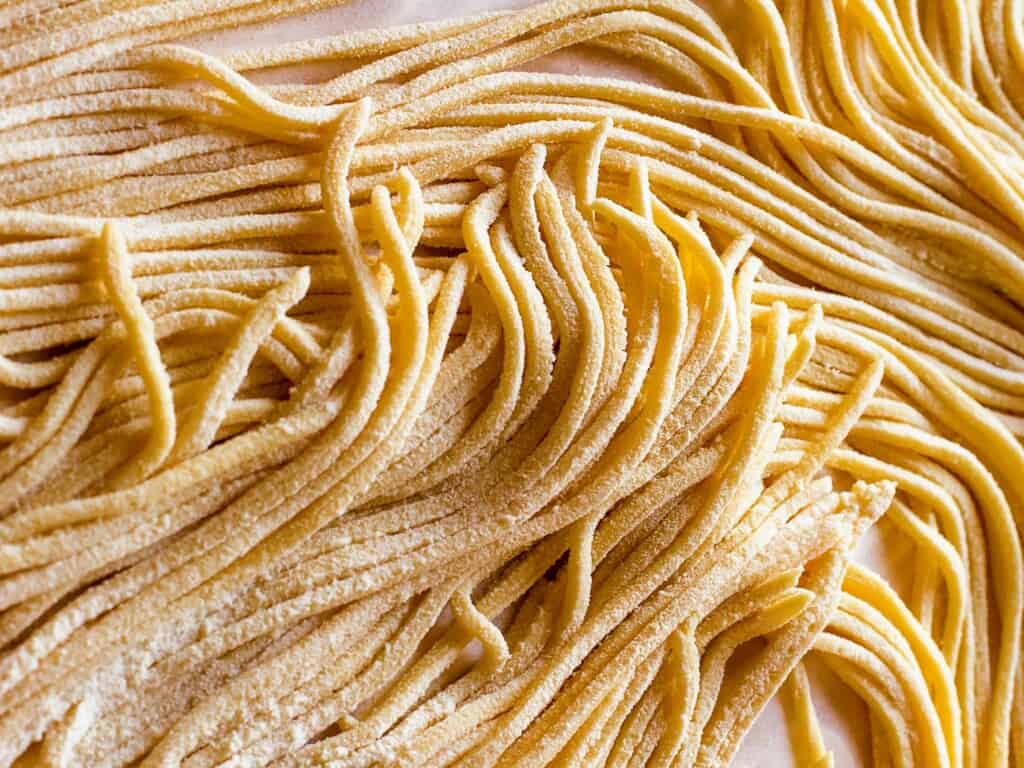
(Pronounced bee-goh-lee in Italian)
Its name refers to the bigolare, the tool used to make this pasta. This is similar to spaghetti but thicker and with a rough surface. Originally made with buckwheat flour, today it’s most commonly made with whole wheat flour, butter, water, and eggs.
Bigoli con l’anatra

(Pronounced bee-goh-lee cohn lahn-ah-trah in Italian)
The locally hand-made pasta bigoli has a rough texture, making it ideal for holding a rich duck ragù flavored with onions, carrots, celery, bay leaves, sage and white wine. Originally all parts of the duck were used to make this ragù, but today only the finest meat and liver is reserved for this sauce.
We Recommend: Cà D’Oro alla Vedova (Venice) is a fantastic restaurant serving up classic Venetian dishes.
Bigoli in Salsa
(Pronounced bee-goh-lee in sahl-sah in Italian)
This is Veneto’s most iconic pasta dish, made from bigoli, dressed in anchovy and onion sauce. The onions and anchovies are slowly cooked until everything is falling apart, creating a silky, creamy sauce perfect for this nutty, whole-wheat pasta.
Spaghetti al Nero di Seppie

(Pronounced spah-geht-tee ahl neh-roh dee sehp-pee-eh in Italian)
This spaghetti served in a dark, almost black cuttlefish ink sauce is iconic in Veneto, but you will also find it in Sicily. The sauce is made by frying cuttlefish and its ink with garlic, olive oil and wine. Very exotic looking!
We Recommend: Osteria La Bottega ai Promessi Sposi (Venice) for classic Venetian dishes such as spaghetti al nero di seppie.
Risi e Bisi
(Pronounced ree-see eh bee-see in Italian)
Risi e Bisi is a risotto-like soup flavored with fresh peas is traditionally served on April 25th in Venice to celebrate its patron, Saint Mark. The most authentic versions have a soup-like consistency without letting the rice get soggy.
More Veg Please: Check out my list of Vegetarian Dishes to Try in Italy.
Risotto alla Trevigiana

(Pronounced ree-soht-toh ahl-lah treh-vee-yahn-ah in Italian)
This risotto is flavored with local radicchio, finished with lots of butter and Parmigiano-Reggiano. One of my personal favorites!
Fact: In Veneto, it is customary to make risotto all’onda, meaning “with waves,” referring to the preferred slightly more liquid consistency of the risotto.
Risotto Amarone
(Pronounced ree-soht-toh ahm-ahr-oh-neh in Italian)
Risotto Amarone from Verona is made with Vialone Nano rice and Amarone red wine, giving it a rich, dark color.
We Recommend: Antica Bottega Del Vino (Verona) serves hands down the best risotto amarone.
Risotto al Nero di Seppia

(Pronounced ree-soht-toh ahl neh-roh dee sehp-pee-ah in Italian)
This black risotto is made with fresh squid or cuttlefish ink. Oftentimes, mussels, clams, and other shellfish are added to the rice. This is a fun dish to order because it is so unusual looking. Just be sure to clean your mouth when you are finished so as not to stain your lips! Just kidding, it won’t stain, but it is easily visible if you get some stuck in your teeth!
Tip: Cuttlefish and squid ink will stain your clothes, so eat carefully!
Risotto Primavera
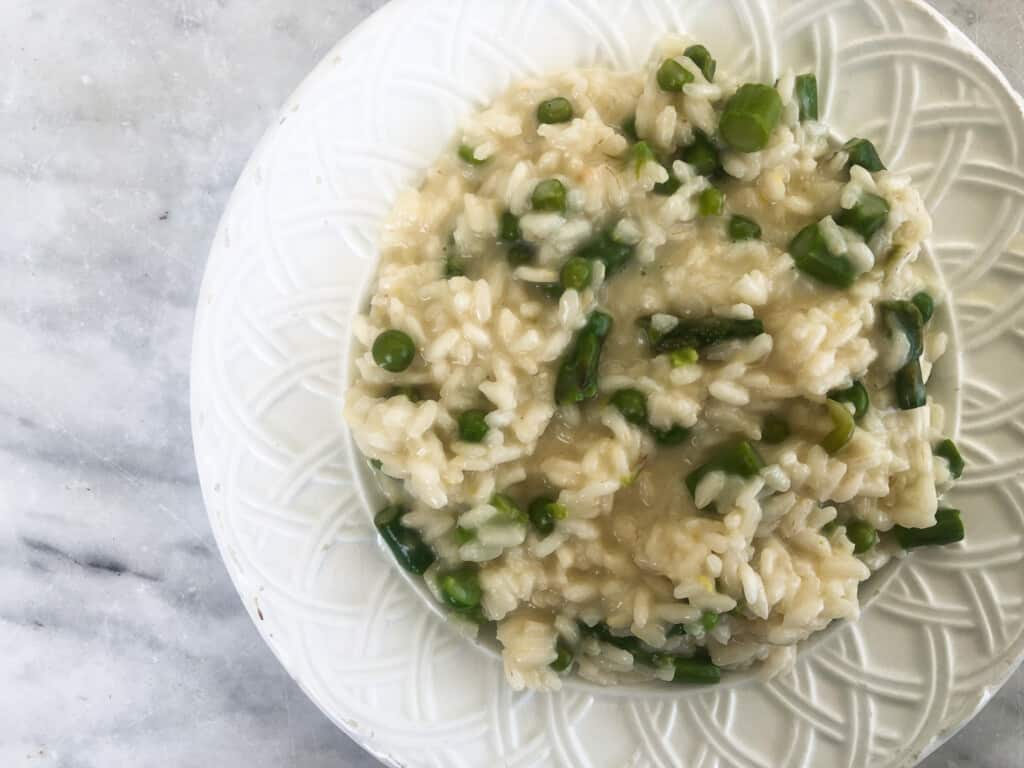
(Pronounced ree-soht-toh pree-mah-vehr-ah in Italian)
Creamy, rich risotto studded with locally grown asparagus, spring onions, shallots, fresh peas and broad beans.
We Recommend: Trattoria da’a Marisa (Venice) is one of only a handful of authentic restaurants left in the city. Unfortunately, so many places have succumbed to the likes of tourism that they have lost a bit of their character and charm. Not this one though! The risotto and fritto misto is particularly good.
Baccalà alla Vicentina

(Pronounced bahk-kah-lah ahl-lah vee-chehn-tee-nah in Italian)
This iconic dish from Vicenza is made from stockfish which must be soaked in water for several days before being cooked. It’s then cooked with onions, anchovies, milk and cheese to make a decadent fish stew
Moeche

(Pronounced moh-eh-keh in Italian)
Moeche is truly a special dish (only available in the spring and fall) made from seasonal soft-shell crabs that have been dipped in egg and flour and fried until golden. Most commonly, they are served with polenta and slices of lemon. When the crabs molt their hard shell, the fishermen only have a short window to catch them because within hours, their new shell has already hardened up again. Because of this, they are considered quite the delicacy but the local fishermen have their techniques to identify which crabs are about to molt their shells to catch them right away!
We Recommend: Trattoria al Gatto Nero (Venice) is the perfect spot for Venetian dishes, especially these little crabs.
Folpetti

(Pronounced fohl-peht-tee in Italian)
This octopus couldn’t be more delicious or satisfying or simple! It’s boiled with herbs and then quickly pan-seared to get that golden crust on the outside. I absolutely love this!
Pearà
(Pronounced peh-ahr-ah in Italian)
Meaning “pepper” in the local dialect, this sauce is made from bread crumbs, bone marrow, olive oil or butter, broth, Parmigiano-Reggiano, salt and pepper and is simmered for hours and often served aside boiled meat.
Fegato alla Veneziana

(Pronounced feh-gah-toh ahl-lah vehn-eh-zee-ah-nah in Italian)
Thinly sliced calf liver is sauteed with caramelized onions, vinegar, white wine or lemon juice, perfectly balancing the hearty, earthy liver with the sweet onion. Typically it is served with grilled polenta, potatoes and/or bread.
We Recommend: You can’t get better liver than at Vini da Gigio (Venice) in our opinion!
Tramezzino Veneziano

(Pronounced trah-mehz-zee-noh veh-neh-zee-ah-noh in Italian)
This is Venice’s version of the Italian favorite tramezzino, a crustless sandwich made from white bread. They are stuffed with various fillings such as tuna and eggs, ham and mushrooms, ham and cheese, mozzarella and tomatoes or arugula and shrimp but they are always made with plenty of mayonnaise. These are commonly sold at bars for quick lunches or hearty snacks.
Ciabatta
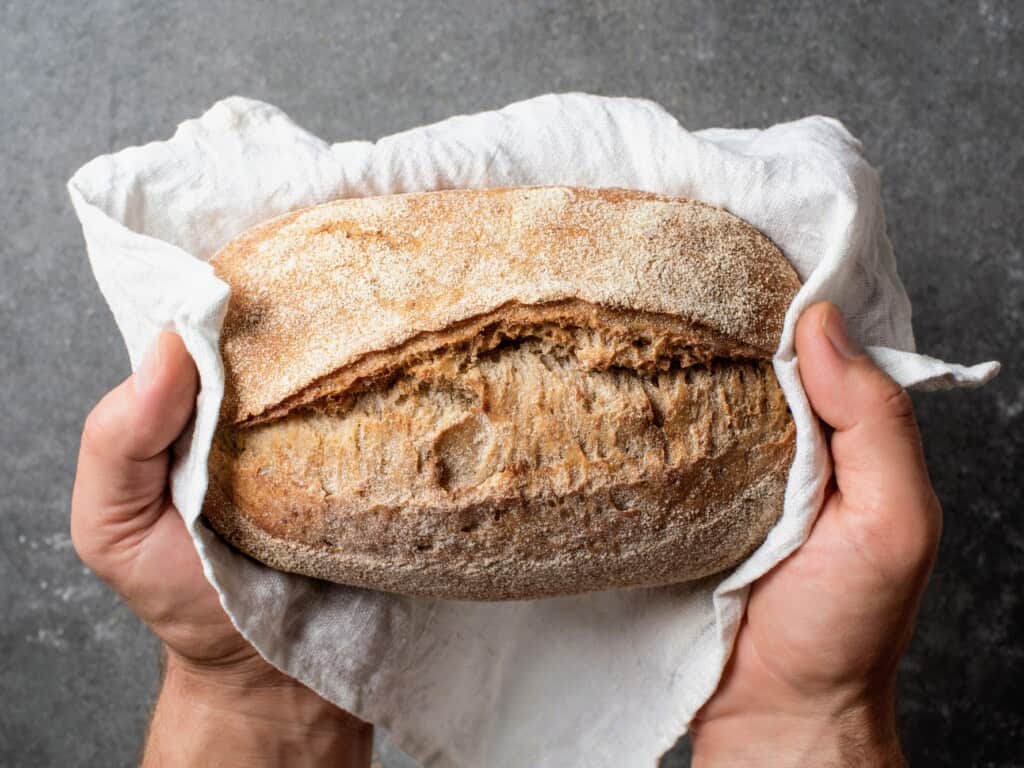
(Pronounced chah-baht-tah in Italian)
Literally meaning “slipper,” referring to its resemblance, this white bread is full of air pockets with a hard, crispy crust, most often described as similar to the taste and texture of the french baguette.
Read More: About ciabatta and other Italian breads in Bread in Italy – Types of Italian Breads & Where to Eat Them
Pan Biscotto
(Pronounced pahn bee-scoht-toh in Italian)
Pan Biscotto is a very simple bread roll typical of Veneto made with flour, water, salt and yeast made to last up to 6 months! They are often served with secondi or with cheese or meat plates.
Pan co a Suca
(Pronounced pahn coh ah soo-cah in Italian)
Pan co a Suca is a sweet pumpkin bread made with whole wheat flour from the area of Treviso. It comes in many different shapes and sizes including small rolls.
Tip: Not a pumpkin fan? Try pan co l’ua (pronounced pahn coh loo-ah in Italian), a raisin bread, instead.
Baicoli
(Pronounced bah-ee-koh-lee in Italian)
Baicoli are long-lasting cookies made from sugar, butter, flour, baking powder, egg whites and milk were historically used by sailors shipping out from Venice because they stayed flavorful and fresh for so long. Today, locals enjoy dipping them into zabaione, vinsanto or hot tea.
Buranelli
(Pronounced boo-rahn-ehl-lee in Italian)

Also known as bussolai or more recently nicknamed Essi, these little butter cookies made on the small island in the Venetian Lagoon, Burano, are typically shaped into the letter “S.” This was another cookie that fisherman or sailors would bring out to sea with them because of their durability.
Focaccia Veneta

(Pronounced foh-kahch-chah veh-neh-tah in Italian)
Also known as fugassa or fugassin in the local dialect, this is a sweet brioche-like bread traditionally made for the Easter holidays (usually in April). What makes this bread so light is its five rises before being baked!
Tiramisù

(Pronounced tee-rah-mee-soo in Italian)
Literally meaning “pick me up,” that is exactly what this caffeinated dessert is supposed to do. It is made by dipping ladyfinger cookies in espresso and layering them between mascarpone cream and cocoa powder. This is one of the few Italian desserts I went through the effort to learn to do right because it is so good!
Make it: Tiramisù is so easy to make at home with our full guide to Authentic Italian Tiramisù Recipe – The Only One You’ll Ever Need (+ Tips)
Frìtole

(Pronounced free-toh-leh in Italian)
These little fried Italian donuts, fritolè, come in all sorts of shapes although a small ball is most traditional, flavored with things like dried fruit or lemon. They can be filled with ricotta, custard or chocolate and although they are typical of Carnival they are nowadays sold in bakeries throughout the year.
We Recommend: Tonolo (Venice) is a tiny pasticceria tucked in the heart of Dorsoduro that produces what are, according to many (me included), the best frìtole in town.
Fregolotta
(Pronounced greh-goh-loht-tah in Italian)
Although originally from Treviso, this huge almond tart or cookie is so delicious it’s now popular throughout the entire region. You can find it in just about any town. Variations include the addition of jams or chocolate.
Nadalin
(Pronounced nah-dah-leen in Italian)
Nadalin is a sweet bread similar to pandoro was first made in the Middle Ages to celebrate the first Christmas under the rule of the Scala Family. Nadalin can be flavored with lemon zest or vanilla and is less buttery, sweeter, and has a denser texture than pandoro. And unlike pandoro, which is finished with a very generous sprinkling of powdered sugar, this Christmas bread is baked with a topping made from sugar, marsala wine, almonds and pine nuts.
We Recommend: Pasticceria Flego (Verona) is one of the city’s most historic bakeries that is particularly well known for its Christmas goods.
Pandoro
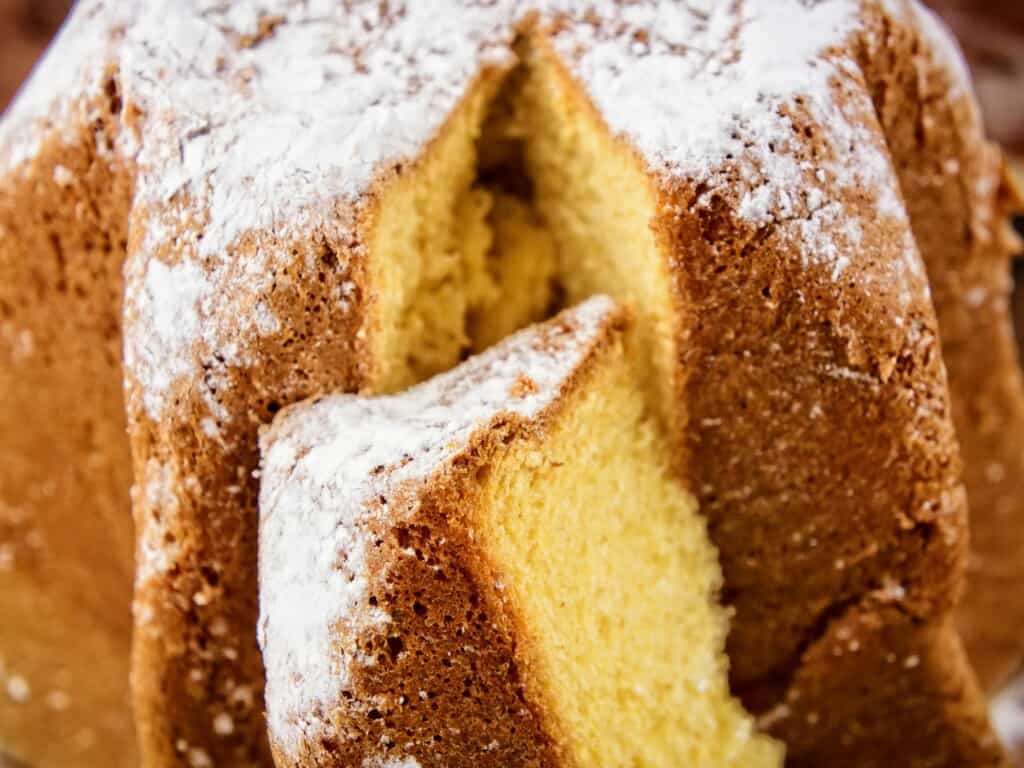
(Pronounced pahn-dohr-oh in Italian)
Its name comes from two Italian words pan and d’oro meaning “bread of gold” referring to its golden color from all the egg yolks used to make this rich brioche-like dough. The dough is flavored with vanilla, without nuts or candied fruit, and is buttery and fluffy. When you purchase it, you will also be given a small bag of powdered sugar which you are meant to sprinkle on the top before serving.
Learn More: Pandoro vs. Panettone – An Italian Christmas Cake Showdown. Make sure you know How to Cut Pandoro.
We Recommend: Pasticceria Perbellini (Bovolone) and Pasticceria Biasetto (Padua) for pandoro.
Risini
(Pronounced ree-see-nee in Italian)
Small round pies made with shortcrust pastry filled with a rich rice pudding and baked until set. These are popular for breakfast with an espresso or cappuccino at local bars throughout the region.
Ingredients and Flavors in the Veneto
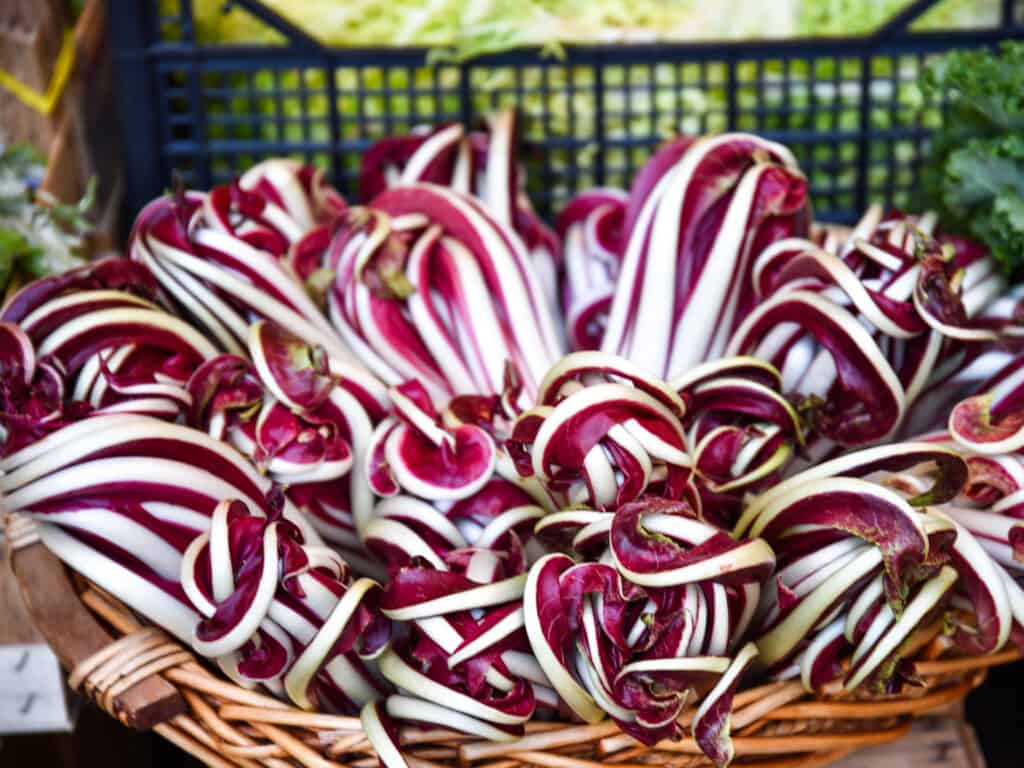
- Fagioli di Lamon: this IGP protected borlotto bean grows just north of Venice and comes in four different varieties: Spanish (most common), Calonega, Canalino and Spagnolit.
- Radicchio Rosso di Treviso: grows particularly well in Treviso, Padua, and Venice. This winter salad has a bitter flavor and is best grilled, baked or used in risotto.
- Vialone Nano Veronese Rice: this PGI protected rice has a medium-sized grain, making it ideal for risotto.
- Moeche: rare soft shell crabs from the Venetian Lagoon available only in the spring and fall when the crabs shed their hard shell.
- Asparagi Bianchi di Bassano: this renowned DOP asparagus is snow white with a sweet yet bitter flavor.
- Carciofo Violetto di Sant’Erasmo: The island of St. Erasmo just outside of Venice grows this variety of purple artichokes. Be sure to try them when you are in Venice as they are very good at doctoring them up!
- Giuggiola dei Colli Euganei: a beautiful tree bearing small brown fruit similar tasting to dates and very high in vitamins.
- Pendole: strips of smoked pork or beef eaten with polenta or simply as a snack.
- Mais Biancoperla: this is a local strain of corn that is very pale white, great for making polenta.

Veneto Wine Worth Drinking
- Recioto di Soave: wines produced in the province of Verona
- Lessini Durello: sparkling white wines made from the Durella variety.
- Gambellara: white wines made from Garganega grapes in Vicenza, Verona and the Lessini Mountains.
- Asolo Prosecco: DOCG Prosecco from Treviso made primarily from the Glera grape.
- Prosecco rosé: made from the Glera and Pinot Noir grapes. To be categorized as prosecco rosé it must be made following the Charmat-Martinotti method which says the second fermentation must happen in pressurized tanks.
- Conegliano Valdobbiadene Prosecco: a DOCG region producing high-quality Prosecco made primarily from Glera grapes complimented with other varieties such as Bianchetta Trevigiana, Perera, and/or Verdiso.
- Recioto della Valpolicella: this is a sweet wine made primarily from air-dried (passito) Corvina grapes. Try this as a digestif or alongside your dessert.
- Valpolicella: a red wine made from Corvina, Corvinone and Rondinella grapes with medium-body and floral and fruity notes. Amarone della Valpolicella and Valpolicella Ripasso (DOC) are the most important of this type of wine.
- Bardolino: a dry red wine made primarily from Corvina and Rondinella grapes outside of Verona around Lake Garda. Don’t miss Bardolino Superiore aged for at least 12 months.
- Soave: This wine can only be produced in the designated Soave area. It comes in three varieties: a dry still Soave, a spumante (sparkling wine), and sweet Recioto.
Regional Cocktails and Liquors in the Veneto
Vov
(Pronounced vohv in Italian)

Vov is an egg-based Venetian liquor invented in 1845 by the candy maker Gian Battista Pezziol. The story goes that he wanted to find a way to use up the extra egg yolks from his nougat confections, so he combined them with Marsala wine and sugar to make Vov.
A bombardino is Italy’s version of eggnog made from brandy, VOV egg liqueur, whipped cream and sometimes topped with cinnamon. It’s one of my favorite ways to enjoy eggs in Italy.
Aperol
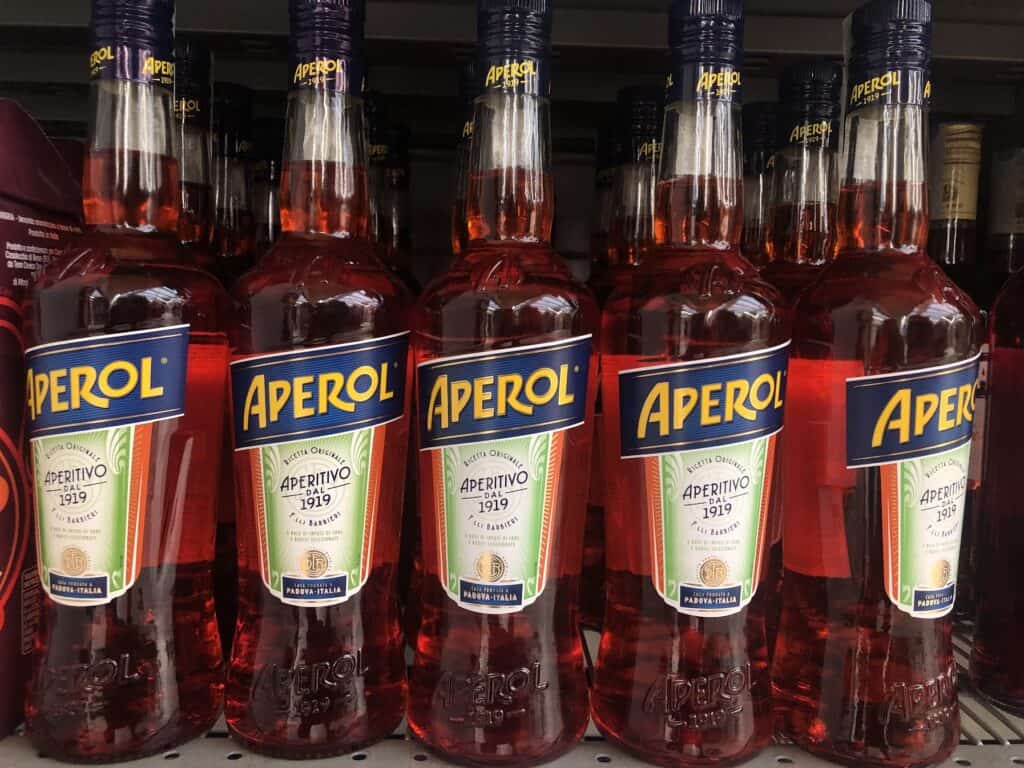
(Pronounced ah-pehr-ohl in Italian)
Aperol was first invented in Padua in 1919 by the Barbieri brothers, and it has only since increased in popularity. The exact recipe is a secret but we know it’s made from both bitter and sweet oranges, rhubarb and various herbs, infusing it with bitter, fruity and floral flavors. It was originally drunk served over ice as an aperitif but today, it is used in many different Italian cocktails.
Aperol Spritz

(Pronounced ah-pehr-ohl spreetz in Italian)
Have you ever wondered what that orange drink, often served in large goblets, is that almost everyone is ordering around you? It’s an Aperol Spritz made from Aperol (3 parts), Prosecco (2 parts) and a splash of soda water, served over ice and garnished with a slice of orange. This is certainly the most popular cocktail in Italy, especially in the summer, and today you will find it has become very popular abroad as well.
And be sure to bring some home (for yourself for a foodie buddy) as well as it carries a hefty price tag overseas in comparison to domestic prices. You can easily replicate the Italian aperitivo experience at home with our recipe for Italian Spritz – The Easy 1-2-3 Recipe For Aperol Spritz.
Tip: Don’t like the taste of Aperol? Try a Campari Spritz, which is much less sweet and slightly bitter. Or, try the sweet and refreshing Limoncello Spritz.
Foodie Experience: Indulging in cocktail hour with a Spritz in Padua is one of our favorite food experiences ever. Read more in Italy Foodie Bucket List – 17 Amazing Italian Culinary Experiences by Region.
Bellini
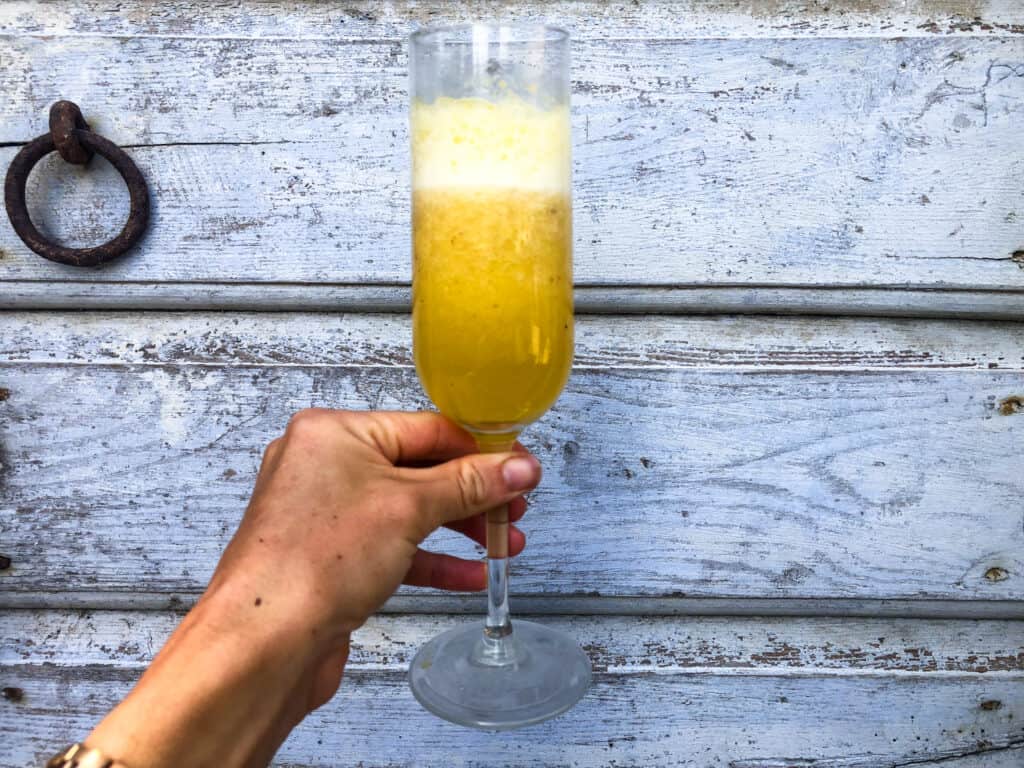
(Pronounced behl-lee-nee in Italian)
Only one drink comes to mind when we think of sophistication: the bellini, one of Italy’s (and the world’s!) most famous drinks today. This simple cocktail made from white peach purée and Prosecco was first invented in the 1930’s by Giuseppe Cipriani of Harry’s Bar in Venice. It’s named after the famous Italian painter Giovanni Bellini, who Cipriani admired.
Venice bound? Get prepared with all of our Venice posts:
20+ Must-Try Foods And Drinks In Venice – And My Favorite Places To Eat Them
What Are Cicchetti? + Where To Eat Them In Venice
What Is A Bacaro? + A Local’s Self Guided Bacaro Tour Itinerary
My Favorite Cicchetti In Venice – The 10 Best Bacari To Try
Best Restaurants in Venice + Nearest Cicchetti Stops
Best Gelato In Venice – My Italian Family’s 10 Favorite Gelaterie
7 Food Markets In Venice Worth Your Time
Where To Get Coffee In Venice
Where To Eat Breakfast In Venice – A Local’s Favorite Breakfast Nooks
10 Amazing Bakeries In Venice – Where to Get Your Pastry On
Best Spots In Venice For Aperitivo – My Top Bars & Squares for Pre-Dinner Drinks
Dinner On The Water In Venice – My Top 7 Restaurants
Best Pizza In Venice – My ‘Don’t Miss’ List
My Favorite After Dinner Drink Spots In Venice
Shopping at the Rialto Market in Venice – Tips + Printable
5 Street Foods To Try In Venice & Where Eat Them
Best Places To Get Takeout In Venice – My Top Picks
Where To Eat Before Catching Your Train At The Venice Santa Lucia Train Station
My Favorite Food Chains To Try In Venice
Eating Gluten-Free In Venice – Restaurants, Cicchetti & Gelato
Gluten-Free Cicchetti In Venice – What To Order (& Avoid) and How to Order
Eating Vegetarian In Venice – My Top Five Vegetarian Friendly Restaurants + Tips
Eating Vegan In Venice, Italy – My Top Five Vegan Friendly Restaurants
Eating in Venice While Pregnant
8+ Kid Friendly Restaurants In Venice
Best Squares To Eat And Drink With Kids In Venice
24 Hour Food Guide For Venice – A Self Guided Tour For Foodies in Venice
Eating Around Venice in 48 hours – 2 Day Venice Itinerary For Foodies
10 Best Food Souvenirs From Venice, Italy + Where I Buy Them
